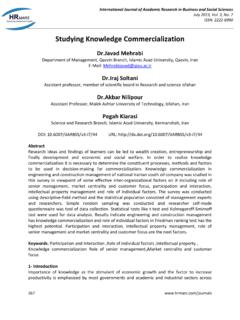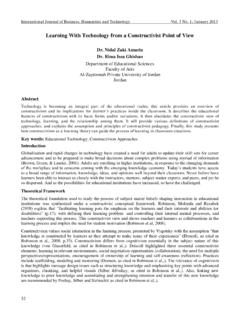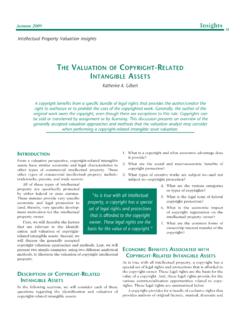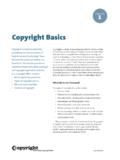Transcription of MUNICIPAL SOLID WASTE MANAGEMENT - World …
1 MUNICIPAL SOLID WASTE MANAGEMENT IN DAR ES SALAAM DRAFT BASELINE ANALYSIS Prepared for the The World Bank Washington, DC Prepared by Robert Breeze Toronto, ON, Canada October 2012 This is an abridged version of a report prepared by Robert Breeze, a consultant engaged by the World Bank. The statements, findings, interpretations, and conclusions expressed in this document are those of the author, and do not necessarily reflect the views of the World Bank. 2 Table of Contents Abbreviations and Acronyms .. 3 Introduction .. 4 Background .. 4 The City of Dar es Salaam .. 4 Methodology .. 4 Existing MSW MANAGEMENT System .. 5 WASTE Quantities and Composition .. 5 Legislative and Policy Framework .. 6 WASTE Collection and Transportation.
2 8 Material Recovery .. 10 Existing Disposal Sites .. 11 Closed Dump Sites .. 12 Baseline Assessment .. 12 Legislative, Regulatory and Policy Framework .. 12 WASTE Quantities and Composition .. 13 WASTE Collection .. 13 WASTE Transportation .. 15 Pugu Landfill .. 16 EFW and 17 APPENDIX 1 - Bibliography .. 18 APPENDIX 2 - SOLID WASTE MANAGEMENT Data .. 20 3 Abbreviations and Acronyms CBE Community Based Enterprise CBO Community Based Organization CCI Clinton Climate Initiative CDM Clean Development Mechanism DCC Dar es Salaam Coordinating Council DLA Dar Local Authority DSM Dar es Salaam EFW Energy from WASTE ERC Environmental Resources Consultancy EWB Engineers without Borders GHG Greenhouse Gas IFC International Finance Corporation ILO International Labour Organization IMC Ilala MUNICIPAL Council JICA Japan International Cooperation Agency KMC Kinondoni MUNICIPAL Council KOICA Korea International Cooperation Agency MRF Material Recovery Facility MSW MUNICIPAL SOLID WASTE NAPA National Adaptation Program of Action NEMC National
3 Environmental MANAGEMENT Council NGO Non-governmental Organization OBA Output-Based Aid PPIAF Public-Private Infrastructure Advisory Facility PPP Public Private Partnerships RDF Refuse Derived Fuel RFP Request for Proposal SW SOLID WASTE TMC Temeke MUNICIPAL Council TZS Tanzanian Shilling 4 IMPROVING MUNICIPAL SOLID WASTE MANAGEMENT IN DAR ES SALAAM Summary Report BASELINE ANALYSIS Introduction This summary report was prepared following a two week mission in Dar es Salaam from March 5 to 17, 2012. During the mission, the consultant met with MUNICIPAL officials, the private sector, NGOs and CBOs and conducted a series of site visits intended to provide an on the ground understanding of existing facilities, system operations and key issues.
4 A workshop was also held on March 7 to bring together the DLAs, the private sector, CBOs and NGOs to review Dar es Salaam s proposed directions, to identify issues and to discuss ideas and approaches for moving forward. Background The City of Dar es Salaam Dar es Salaam is the country s largest industrial and commercial centre with an estimated population of more than 4 million in 2012 and a population growth rate of percent. The total land area is about 1,500 km with a population density of around 2,700 persons per km . More than seventy percent of the population live in unplanned and under-serviced areas of the city. The Dar es Salaam MUNICIPAL government is composed of the Dar es Salaam City Council (DCC) and three contiguous MUNICIPAL Councils: Kinondoni (KMC) to the north, Ilala (IMC) in the center, and Temeke (TMC) to the south.
5 Together, the four local governments are commonly referred to as the Dar es Salaam Local Authorities (DLAs). Methodology The MSW system in Dar es Salaam (DSM) has been the subject of detailed study by international donors for more than 30 years. Since 1979, there have been six major international 5 studies focusing exclusively on the overall SOLID WASTE MANAGEMENT system. Several have proposed comprehensive SOLID WASTE master plans for the city. There have also been numerous reports recommending improvements to the MSW system as part of broader sanitation, capacity building or environmental planning initiatives. In addition, twenty six proposals have been received by the DLAs since 1997 for Energy from WASTE (EFW) facilities including a detailed proposal with funding from the Korea Organization for International Cooperation Agency (KOICA) in 2011.
6 The Clinton Climate Initiative (CCI) proposed the development of a centralized composting facility at the Pugu landfill to manage organic market wastes. Few of the recommendations proposed in the reports have been implemented due to a lack of funds and the capacity of the DLAs to assess the reports and put the recommendations into action. In 2011, the DLAs developed a project plan, without international donor assistance, for investments in the MSW system. The DLA SOLID WASTE project plan draws on the major findings and recommendations from the earlier studies and demonstrates a clear understanding of the issues and the way forward for MSW in Dar es Salaam. The DLA project plan was taken as the starting point for this baseline report.
7 This baseline report is based on a compilation and analysis of the existing work undertaken by previous international consultancies. It was supplemented with a series of meetings with key DLA officials, private sector operators, CBOs and NGOs to confirm issues and to identify suggested areas for improvement. Site visits were used to `ground truth` the findings. In addition, a workshop was held on March 7 to bring together the DLAs, the private sector, CBOs and NGOs to review the draft DLA project plan, to identify issues and to find a way forward. The meetings, site visits and attendees at the workshop are listed in Appendices 4, 5 and 6. The SW TOR prepared as the first output for the Mission and attached as Appendix 7 to this report is a consensus document between the World Bank consultant and the four SOLID WASTE focal points.
8 These focal points represent each of the four DLAs: Dar es Salaam, Kinondoni, Ilala and Temeke City Councils. Their names are listed in Appendix 4. Existing MSW MANAGEMENT System WASTE Quantities and Composition It has been estimated by the DLAs that approximately 4,200 tonnes per day of SOLID WASTE were generated in DSM in 2011. This represents a generation rate of kg/cap/day based on a population of million. Using a population growth rate of and a generation rate of kg/cap/day, Environmental Resources Consultancy (ERC) has estimated that DSM could be generating over 12,000 tonnes per day by represents a tripling of the WASTE generated 6 in just 14 years. The growth rate is of particular concern considering the small increases anticipated in the DLA capital and operating budgets.
9 The DLAs have also estimated that less than 40% of the total wastes generated in the city are collected and disposed of in the Pugu dump site or otherwise recovered. The remaining wastes (approximately 60%) are either dumped by the road side or into drainage canals contributing to health problems for local residents, annual flooding events and methane generation. Table 1 shows the estimated tonnes of WASTE generated by each of the three DLAs and the actual amounts collected. Much of the WASTE quantities that are not collected are from unplanned areas of the city. Introducing collection to these unplanned areas is a challenge given the lack of local awareness, institutional capacity, funds and the condition of area roads for collection vehicles.
10 Table 1 SOLID WASTE Generated and Collected Municipality Amount Generated (Tonnes) Amount Collected (Tonnes) Collection Rate (%) Ilala 1,100 430 39 Temeke 1,035 280 27 Kinondoni 2,026 823 41 Total 4,161 1,533 37 Source: Dar es Salaam Metropolitan Development Projects 2011, WASTE MANAGEMENT Projects Proposals Many of the donor studies conducted WASTE quantity and composition studies. These studies confirmed that about 40% of the wastes are organics from kitchens, followed by 16% plastics, 10% yard WASTE and 8% paper. Metals constitute 5% and ceramics / stone about 6% of the total. This distribution, particularly for the organic fraction, is typical of cities with incomes similar to DSM. None of the studies determined the heating value of the WASTE but it is estimated to be as low as 10,000 to 12,000 kJ/kg with moisture contents from 30 to 40% depending on the time of year.
















